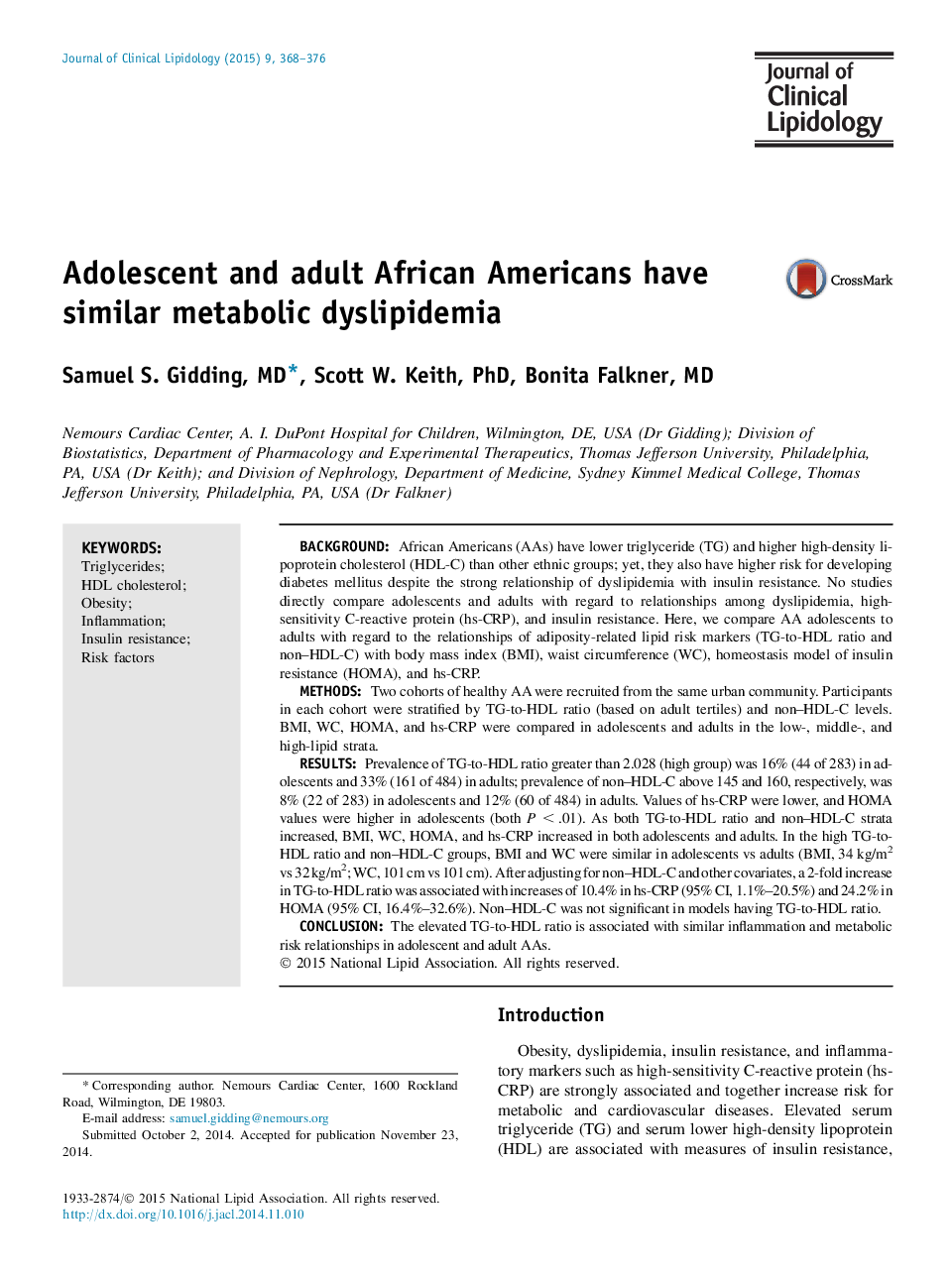| کد مقاله | کد نشریه | سال انتشار | مقاله انگلیسی | نسخه تمام متن |
|---|---|---|---|---|
| 5985556 | 1178777 | 2015 | 9 صفحه PDF | دانلود رایگان |
- Studies comparing adolescents and adults with regard to metabolic disturbances related to dyslipidemia have not been performed.
- African Americans experience metabolic disturbances at lower levels of triglycerides than Caucasians.
- When stratified by triglyceride-to-high-density lipoprotein cholesterol (HDL-C) ratio or by non-HDL-C level, adolescent African Americans have similar body mass index and waist circumference as adults.
- As triglyceride-to-HDL-C ratio increases, homeostasis model of insulin resistance and high-sensitivity C-reactive protein increase, the slope of this relationship is steeper in adolescents compared with adults.
- Triglyceride-to-HDL-C ratio is a more important determinant of metabolic risk than non-HDL-C.
BackgroundAfrican Americans (AAs) have lower triglyceride (TG) and higher high-density lipoprotein cholesterol (HDL-C) than other ethnic groups; yet, they also have higher risk for developing diabetes mellitus despite the strong relationship of dyslipidemia with insulin resistance. No studies directly compare adolescents and adults with regard to relationships among dyslipidemia, high-sensitivity C-reactive protein (hs-CRP), and insulin resistance. Here, we compare AA adolescents to adults with regard to the relationships of adiposity-related lipid risk markers (TG-to-HDL ratio and non-HDL-C) with body mass index (BMI), waist circumference (WC), homeostasis model of insulin resistance (HOMA), and hs-CRP.MethodsTwo cohorts of healthy AA were recruited from the same urban community. Participants in each cohort were stratified by TG-to-HDL ratio (based on adult tertiles) and non-HDL-C levels. BMI, WC, HOMA, and hs-CRP were compared in adolescents and adults in the low-, middle-, and high-lipid strata.ResultsPrevalence of TG-to-HDL ratio greater than 2.028 (high group) was 16% (44 of 283) in adolescents and 33% (161 of 484) in adults; prevalence of non-HDL-C above 145 and 160, respectively, was 8% (22 of 283) in adolescents and 12% (60 of 484) in adults. Values of hs-CRP were lower, and HOMA values were higher in adolescents (both PÂ <Â .01). As both TG-to-HDL ratio and non-HDL-C strata increased, BMI, WC, HOMA, and hs-CRP increased in both adolescents and adults. In the high TG-to-HDL ratio and non-HDL-C groups, BMI and WC were similar in adolescents vs adults (BMI, 34Â kg/m2 vs 32Â kg/m2; WC, 101Â cm vs 101Â cm). After adjusting for non-HDL-C and other covariates, a 2-fold increase in TG-to-HDL ratio was associated with increases of 10.4% in hs-CRP (95% CI, 1.1%-20.5%) and 24.2% in HOMA (95% CI, 16.4%-32.6%). Non-HDL-C was not significant in models having TG-to-HDL ratio.ConclusionThe elevated TG-to-HDL ratio is associated with similar inflammation and metabolic risk relationships in adolescent and adult AAs.
Journal: Journal of Clinical Lipidology - Volume 9, Issue 3, MayâJune 2015, Pages 368-376
